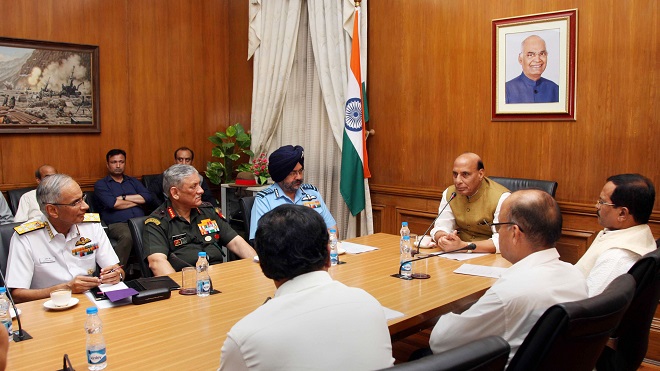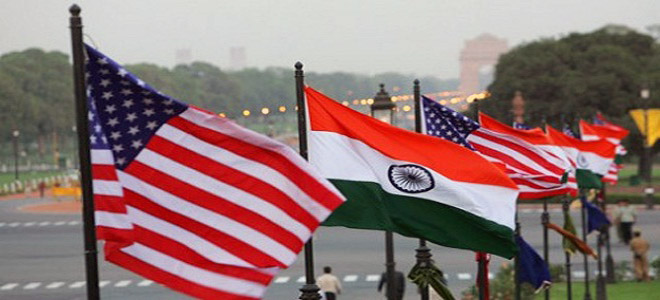
Newly appointed Defence Minister Rajnath Singh during a meeting with Gen Bipin Rawat, Chief of the Naval Staff Admiral Karambir Singh, Air Chief Marshal BS Dhanoa and others, in New Delhi, Saturday, June 1, 2019. Photo: PTI.
NEW DELHI (PTI): As India's new defence minister, Rajnath Singh's most crucial challenge will be to speed up the long-delayed modernisation of the three services besides ensuring overall coherence in their combat readiness.
His another challenge will be to ensure peace and tranquillity along the frontier with China while developing required military infrastructure to deal with any possible Chinese hostility.
As he takes charge of the ministry just three months after India carried out air strikes on a terrorist training camp in Pakistan's Balakot, it is expected that he will continue with the policy of hot pursuit in dealing with cross border terrorism.
Containing infiltration of terrorists into Jammu and Kashmir from Pakistan will be another key focus area.
As the Defence Minister, Singh will face the challenge of strengthening the combat capabilities of the Army, Navy and the Air Force due to changing regional security matrix and geo-political dynamics.
The forces have been pressing for equipping them to deal with hybrid warfare and Singh will have to attend to this crucial demand.
The government has been focusing on domestic defence production and Singh will have to carry forward a number of big-ticket reform initiatives, including implementing the ambitious "strategic partnership" model.
Under the new model, select Indian private firms will be roped in to build military platforms like submarines and fighter jets in India in partnership with foreign defence majors.
Singh also faces the challenge of modernising the defence research organisations and various other defence public sector undertakings so that they can produce state-of-the art military hardware to match requirement of the forces.
He is expected to focus on simplification of the acquisition process as majority of the military modernisation programmes are delayed due to administrative hurdles.
Singh, who was Home Minister in the previous government, will also have to oversee carrying out of major reforms in the 12-lakh strong Army.
The Army has already finalised a blueprint for its reform including right-sizing of the force.
His predecessor Nirmala Sitharaman had taken on the opposition head-on with her fiery defence of the Rafale fighter jet deal and it will be interesting to see how Singh deals with the issue.
Soon after taking charge as Defence Minister, Rajnath Singh Saturday asked the chiefs of the Army, Navy and the Air Force to prepare separate presentations on the challenges and overall functioning of their respective forces.
Singh held a held a meeting with Army chief Gen Bipin Rawat, Chief of Air Staff Air Chief Marshal B S Dhanoa and newly-appointed Navy chief Karambir Singh at the headquarters of the defence ministry at the Raisina Hills during which he was apprised about the security scenario, officials said.
Minister of State for Defence Shripad Naik, Defence Secretary Sanjay Mitra and several top officials of the ministry were also present at the meeting.
 Previous Article
Previous Article Next Article
Next Article













The Indian Air Force, in its flight trials evaluation report submitted before the Defence Ministry l..
view articleAn insight into the Medium Multi-Role Combat Aircraft competition...
view articleSky enthusiasts can now spot the International Space Station (ISS) commanded by Indian-American astr..
view article